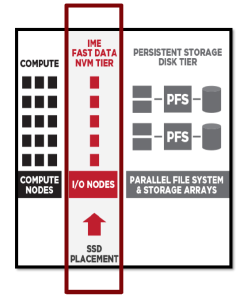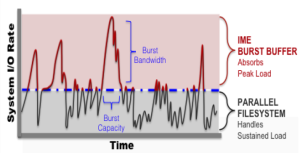Today at Supercomputing 2014, DataDirect Networks lifted the veil a bit more on Infinite Memory Engine (IME), its new software that will employ Flash storage and a bunch of smart algorithms to create a buffer between HPC compute and parallel file system resources, with the goal of improving file I/O by up to 100x. The company also announced the latest release of its Exascaler, its Lustre-based storage appliance lineup.
The data patterns have been changing at HPC sites in a way that is creating bottlenecks in the I/O. While many HPC shops may think they’re primarily working with large and sequential files, the reality is that most data is relatively small and random, and that fragmented I/O creates problems when moving the data across the interconnect, says Jeff Sisilli, Sr. Director Product Marketing at DataDirect Networks.
“Parallel file systems were really built for large files,” Sisilli tells HPCwire. “What we’re finding is 90 percent of typical I/O in HPC data centers utilizes small files, those less than 32KB. What happens is, when you inject those into a parallel file system, it starts to really bring down performance.”
DDN says it overcame the restrictions in how parallel file systems were created with IME, which creates a storage tier above the file system and provides a “fast data” layer between the compute nodes in an HPC cluster and the backend file system. The software, which resides on the I/O nodes in the cluster, utilizes any available Flash solid state drives (SSDs) or other non-volatile memory (NVM) storage resources available, creating a “burst buffer” to absorb peak loads and eliminate I/O contention.
 IME works in two ways. First, it removes any limitations of the POSIX layer, such as file locks, that can slow down communication. Secondly, algorithms bundle up the small and random I/O operations into larger files that can be more efficiently read into the file system.
IME works in two ways. First, it removes any limitations of the POSIX layer, such as file locks, that can slow down communication. Secondly, algorithms bundle up the small and random I/O operations into larger files that can be more efficiently read into the file system.
In lab tests at a customer site, DDN ran IME against the S3D turbulent flow modeling software. The software was really designed for larger sequential files, but is often used in the real world with smaller and random files. In the customer’s case, these “mal-aligned and fragmented” files were causing I/O throughput across the InfiniBand interconnect to drop to 25 MBs per second.
After introducing IME, the customer was able to ingest data from the compute cluster onto IME’s SSDs at line rate. “This customer was using InfiniBand, and we were able to fill up InfiniBand all the way to line rate, and absorb at 50 GB per second,” Sisilli says.
The data wasn’t written back into the file system quite that quickly. But because the algorithms were able to align all those small files and convert fragments into full stripe writes, it did provide a speed up compared to 25MB per second. “We were able to drain out the buffer and write to the parallel file system at 4GB per second, which is two orders of magnitude faster than before,” Sisilli says.
The “net net” of IME, Sisilli says, is it frees up HPC compute cluster resources. “From the parallel file system side, we’re able to shield the parallel file system and underlying storage arrays from fragmented I/O, and have those be able to ingest optimized data and utilize much less hardware to be able to get to the performance folks need up above,” he says.
IME will work with any Lustre- or GPFS-based parallel file system. That includes DDN’s own EXAscaler line of Lustre-based storage appliances, or the storage appliances of any other vendor. There are no application modifications required to use IME, which also features data erasure encoding capabilities typicaly found in object file stores. The only requirements are that the application is POSIX compliant or uses the MPI job scheduler. DDN also provides an API that customers can use if they want to modify their apps to work with IME; the company has plans to create an ecosystem of compatible tools using this API.
There are other vendors developing similar Flash-bashed storage buffer offerings. But DDN says the fact that it’s taking an open, software-based approach gives customer an advantage over those vendors that are requiring customers to purchase specialized hardware, or those that work with only certain types of Interconnects.
 IME isn’t available yet; it’s still in technology preview mode. But when it becomes available, scalability won’t be an issue. The software will be able to corral and make available petabytes worth of Flash or NVM storage resources living across thousands of nodes, Sisilli says. “What we’re recommending is [to have in IME] anywhere between two to three amount of your compute cluster memory to have a great working space within IME to accelerate your applications and and do I/O,” he says. “That can be all the way down to terabytes, and for supercomputers, it’s multi petabytes.”
IME isn’t available yet; it’s still in technology preview mode. But when it becomes available, scalability won’t be an issue. The software will be able to corral and make available petabytes worth of Flash or NVM storage resources living across thousands of nodes, Sisilli says. “What we’re recommending is [to have in IME] anywhere between two to three amount of your compute cluster memory to have a great working space within IME to accelerate your applications and and do I/O,” he says. “That can be all the way down to terabytes, and for supercomputers, it’s multi petabytes.”
IME is still undergoing tests, and is expected to become generally available in the second quarter of 2015. DDN will offer it as an appliance or as software.
DDN also today unveiled a new release of EXAScaler. With Version 2.1, DDN has improved read and write I/O performance by 25 percent. That will give DDN a comfortable advantage over competing file systems for some time, says Roger Goff, Sr. Product Manager for DDN.
“We know what folks are about to announce because they pre-announce those things,” Goff says. “Our solution is tremendously faster than what you will see [from other vendors], particularly on a per-rack performance basis.”
Other new features in version 2.1 include support for self-encrypting drives; improved rebuild times; InfiniBand optimizations; and better integration with DDN’s Storage Fusion Xcelerator (SFX Flash Caching) software.
DDN has also standardized on the Lustre file system from Intel, called Intel Enterprise Edition for Lustre version 2.5. That brings it several new capabilities, including a new MapReduce connector for running Hadoop workloads.
“So instead of having data replicated across multiple nodes in the cluster, which is the native mode for HDFS, with this adapter, you can run those Hadoop applications and take advantages of the single-copy nature of a parallel file system, yet have the same capability of a parallel file system to scale to thousands and thousands of clients accessing that same data,” Goff says.
EXAScaler version 2.1 is available now across all three EXAScaler products, including the entry-level SFA7700, the midrange ES12k/SFA12k-20, and the high-end SFA12KX/SFA212k-40.
Related Items:
DDN Discusses Enterprise HPC Momentum
DDN’s IME Software Scales I/O Performance on the Rocky Road to Exascale
DDN Aims for Deeper, Cheaper Archives





























































